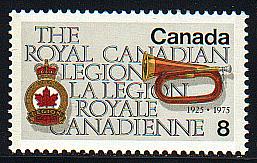Stamps and
Remembrance |
|
Stamps and
Remembrance |
|
November 11th, the day Canadians remember the men and women who sacrificed their lives in time of war - more than 100,000 who died in the First World War (1914 - 1918), the Second World War (1939 - 1945) and the Korean War (1950 - 1953). We show that we remember by wearing poppies, by pausing for two minutes of silent tribute, and by attending commemorative ceremonies. Tribute has also been paid to Canada's war dead through the medium of postage stamps.
The Memorial Chamber commemorative was issued in 1938 as part of the Pictorials Issue. Opened in 1928, it is located on the third floor of the Peace Tower in Canada's Parliament Buildings. It was originally built to honour those who fought in the First World War. Its scope has since been expanded to include key events in Canada's military history from 1866 to the present.
|
Constructed of materials provided by the three original allies, the
ceiling, walls and columns of the chamber are constructed of Château Gaillard stone from
France, the altar is from Britain, the border and altar steps are made
from black marble donated by Belgium, and the floor is of stone brought from where
Canadians fought. There are three stained glass windows featuring allegorical scenes entitled Call-To-Arms (east window), The Assembly of Remembrance (south window), and The Dawn of Peace (west window). Also inscribed in one wall is the poem, In Flanders Fields, and on the walls there are scenes of Canadian heroism from the First World War. |
The Memorial Chamber's Remembrance Books have an important role to play in the act of remembrance. A page is turned each day in a ceremony held at 11:00 a.m., the hour of the Armistice of November 11, 1918. Every twelve months, each name in every book appears at least once.
One of the set of Royal Visit stamps, the War Memorial commemorative was issued in 1939. His Majesty King George VI unveiled it in that year. Originally constructed to honour Canadians who died in the First World War, the dates 1939-1945 and 1950-1953 were subsequently added to remember those who served in the Second World War and the Korean War.
|
|
Based on a model called The Response, submitted by Englishman Vernon March in response to an international competition held in 1925, the National War Memorial features 22 bronze figures advancing through an archway. The figures represent the hundreds of thousands of Canadians from all branches of the Service who were engaged in the First World War. The granite archway is surmounted by the bronze figures of Peace and Freedom, conveying the message that one cannot exist for long without the other.
Fighting together for the first time, four Canadian divisions seized Vimy Ridge on April 12, 1917 after four days of ferocious combat. Two previous attempts by allies to dislodge the enemy from the heavily fortified height were unsuccessful. The innovative use of technology, meticulous preparation, and the sacrifice of thousands of young men's lives produced this remarkable victory, which, for Canada, was a turning point in the war and the beginning of a sense of nationhood.
|
Issued to mark the 50th anniversary of Armistice ending the First World War, this stamp features the Vimy Memorial. For Canadians, the taking of Vimy Ridge stands as a feat of arms of exceptional courage and sacrifice. Vimy has also become a central place of remembrance dedicated to those soldiers who died in France and who have no known grave. This site of victory but also of death is marked by the work of Canadian sculptor Walter Allward. His distinctively modernistic design depicts grieving figures beneath two towering pylons of limestone. The names of the 11,285 missing Canadians who died in France during the First World War are inscribed on the monument. |
|
John McCrae wrote his famous poem, In Flanders Fields, the day after one of his closest friends was killed in the Second Battle of Ypres, which took place in an area known as Flanders, Belgium, in April 1915. Canadian soldiers fought valiantly, despite the dreadful effects of chlorine gas, which was first used in this battle. His friend along with thousands of others were buried in makeshift graves marked with simple wooden crosses, and wild poppies were already beginning to bloom between them. It was the second last poem he was to write. He died of pneumonia and meningitis on January 28, 1918.
|
John McCrae is commemorated on this stamp issued in 1968, 50 years after his death. The poppy, which has been adopted as the Flower of Remembrance for the war dead of Britain, France, the United States, Canada and other Commonwealth countries, and John McCrae's poem, In Flanders Fields, are inexorably linked to Remembrance Day. |
|
Committed to the Remembrance of those who gave their lives for peace and freedom, The Royal Canadian Legion was formed in 1925 with a membership of 50,000. Today, with more than 500,000 members and 1690 branches in Canada, the USA and Germany, the Legion is the largest community service organization in Canada. As well as providing service to veterans and the community, the Legion continues to promote Canada's contribution to world peace, the protection of Canadian sovereignty and the preservation of national unity. This stamp commemorated its 50th anniversary in 1975.

| The author
would very much appreciate any feedback on this publication. Information pertaining to errors and omissions, helpful suggestions, and offers to provide additional material, etc, are more than welcome. |
|
All rights reserved. No information contained within this publication is to be used for financial gain without the expressed, written permission of the author.
Updated: 10 Oct 98